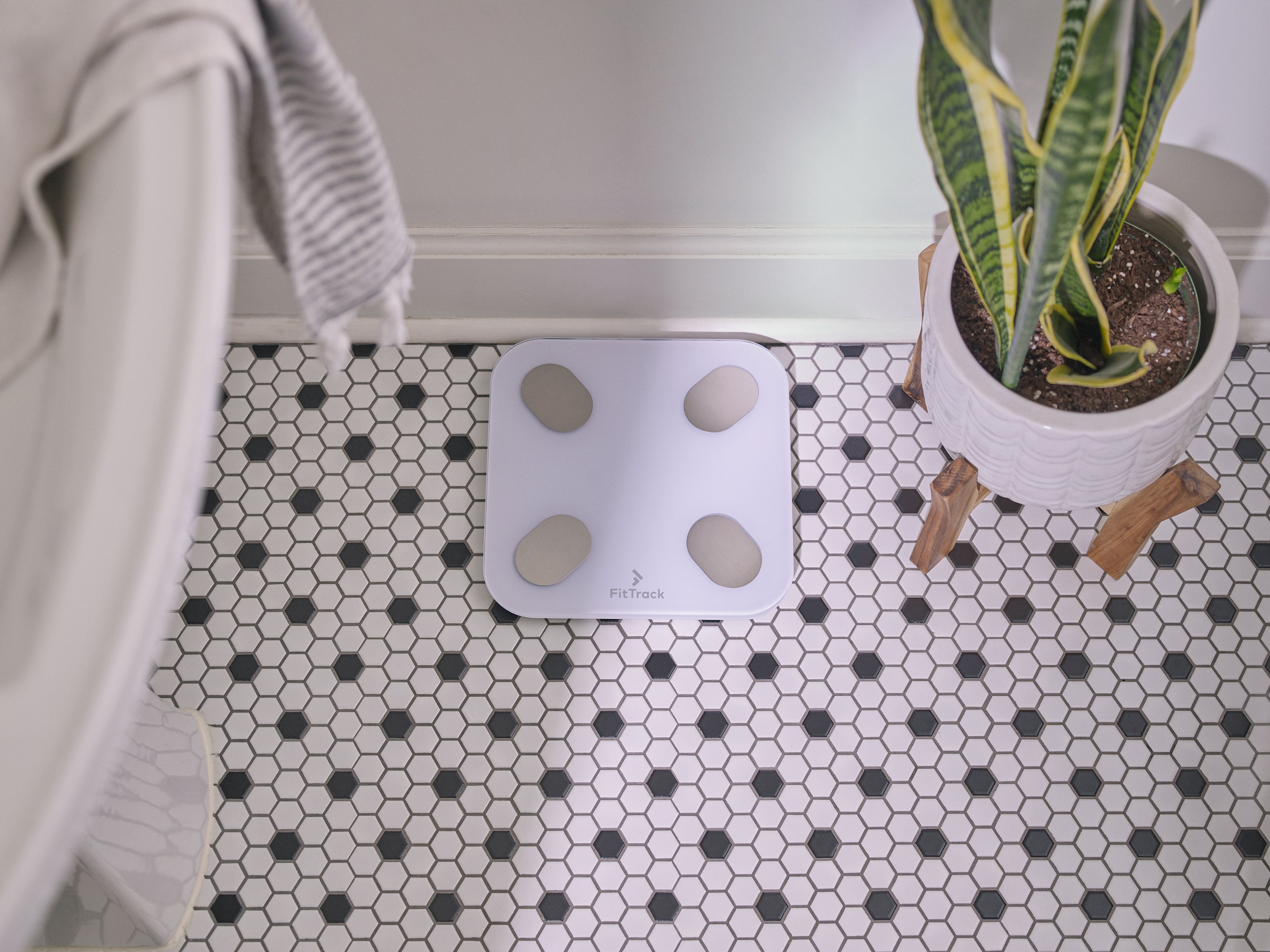Subcutaneous Fat - Do I Have Too Much?
Many people don't know that there are different types of body fat that all of us have. Subcutaneous and visceral fat are the two main types of fat stored in our bodies, but each plays a different role in our health and longevity.
Subcutaneous fat is the fat storage directly underneath our skin
Related: How The FitTrack Measures Body Fat
To understand how this stored body fat affects our health, it's important to learn the difference between these two types of fat and what we can do to mitigate the health risks that come along with them.

Track Your Visceral and Subcutaneous Fat With The Fittrack Beebo
What is Subcutaneous fat?
Subcutaneous fat is the layer of stored fat between the skin and muscles in our body. Every amount of fat that we can see externally is this type of fat. Each of us has a different amount of subcutaneous fat which can affect our overall health and well-being. Too much adipose tissue, no matter where it is located, is a health risk.

Fat cells are simply a stored form of energy, and unless we are going to experience long bouts of fasting, having too much-stored body fat is only detrimental to our health and longevity. Obese people may be carrying around quite a bit of subcutaneous fat.
However, this isn't the most harmful fat type in our bodies.
Visceral Fat vs Subcutaneous Fat - Which is healthier?
A study performed in 2015 found that people with excess visceral fat, or the fat around the organs, were more likely to die when they had less subcutaneous fat. (medicalnewstoday.com)
While we know that obesity in any form can increase health risks, carrying too much visceral fat seems more dangerous than subcutaneous fat.
Even so, many of us aiming for weight loss care a lot about our appearance along with our health, so reducing both types of stored body fat is the goal.
This doesn't mean that having a high BMI is automatically healthy if your visceral fat levels are low. It simply means the risk factors are slightly different in this case. Having a large body mass will increase the risk for health problems across the board.
What Causes It?
Fatty acids are consumed through food. Other nutrients, such as carbs and protein can also be converted to fatty acids when calories are abundant. This state is known as a calorie surplus, where you consume more calories than you need to sustain your body weight. Being in this state regularly will cause weight gain, with the majority of it being adipose tissue. Your metabolism plays a large part in how many calories you need to maintain your body mass.
Factors that can affect your metabolic rate include the quality of your sleep, insulin resistance, chronic inflammation, hormone balance, and amount of daily physical activity.
Eating too many calories and not accounting for the health of your metabolism can set you on the fast track to adiposity, high blood pressure, type 2 diabetes, heart disease, raised cholesterol clogging blood vessels, and many more conditions intertwined in metabolic syndrome.
Signs of Visceral Fat
What is commonly mislabeled as belly fat, is actually adipose tissue surrounding our internal organs. While this type of fat isn't visible to the naked eye, there are some telltale signs that visceral fat is abundant:
- Unusually high waist circumference in comparison to total body fat percentage.
- An increased amount of circulating inflammatory cytokines. (ncbi.nlm.nih.gov)
Knowing the exact amount of visceral fat would require a CT scan, which is unnecessary for most of us. Simply undergoing a fat loss regimen will be enough to start losing harmful visceral fat if you currently have too much. You can't spot reduce abdominal fat, or fat anywhere on your body for that matter. However, losing fat consistently will help reduce the amount of fat cells around your organs over time.
Signs of Subcutaneous Fat
Subcutaneous adipose tissue is the easiest type of fat to spot. Simply grab a skinfold with your finger and your thumb and you are pinching some amount of this type of fat. Body fat calipers are a great way to get a measure of how much fat lies below your skin.
The clearcut sign that you have this type of fat is to flex your muscles in a certain area. If you rustle the area you are flexing and it jiggles, there is subcutaneous adipose tissue present (along with loose skin, water, and other tissue).
The signs of subcutaneous fat are notable between males and females. This difference becomes marked during adolescence when, on average, fat represents 25% of body weight in females but only 15% of body weight in males. (sciencedirect.com) However, the majority of this difference in fat doesn’t involve visceral fat, as being a male or female doesn’t automatically increase your amount of visceral fat.
How To Lose Subcutaneous Fat
Fat loss starts with the primary necessity of being in a calorie deficit. This means that you consume fewer calories than it takes to maintain your body weight. A recent meta-analysis examined low fat and low carb diets to see if either was better at fat loss. (academic.oup.com). While it found that diets low in carbs increased weight loss, they didn’t increase fat loss over low-fat diets. This means calories in vs calories out is truly the main factor of fat loss.
Recall that many things affect your metabolism, so ensuring your lifestyle factors don't hinder your metabolic rate will speed up weight loss efforts. Your dietary choices can make or break your fat loss efforts. Choosing healthy food that helps reduce insulin resistance and nutrient deficiencies can be just as important as the number of calories you consume.
When losing weight in a sedentary state, your body will use any form of stored energy, including muscle cells and glycogen. To ensure that we are working towards fat loss and not just overall weight loss, adding in strength training and aerobic exercise is a great addition to the plan.
Losing this type of fat can be as easy as liposuction as well. This won’t reduce visceral fat at all, so liposuction is more for aesthetics than health. The same can be said for weight loss drugs. In reality, all forms of intervention for fat loss will reduce subcutaneous adipose tissue to a higher degree than visceral fat. (pubmed.ncbi.nlm.nih.gov) Dieting and exercise is the best way to reduce both.
The role of diet in losing subcutaneous fat
Your dietary choices will make or break your fat loss efforts. You cannot out-exercise a bad diet. You can’t get liposuction and continue eating a bad diet, as you’ll simply put on more fat cells. If you want lasting fat loss results, your diet is the most important factor.
Knowing how many calories you should be eating per day and ensuring that these calories come from the most nutritious foods possible is the best course of action. Your diet affects your body weight and your overall wellness, including risks for cardiovascular disease and many other diseases associated with metabolic syndrome.
Other lifestyle strategies for fighting subcutaneous fat
There are a few things that you can add to a well-planned nutritional protocol to help with fat loss and improving your health. Here is a quick list:
- Regular strength training
- Aerobic exercise daily (it doesn’t have to be an all-out sprint)
- Optimized sleep
- Efforts to reduce insulin resistance (diet and exercise take care of this mostly)
- Balancing your hormones (naturally or with the help of a licensed professional)
- Reducing inflammation in your body (less inflammatory foods and more hormetic stressors)
If you combine these lifestyle factors with good dietary choices, you have a very good chance of reducing both types of fat stored in your body!
 |
About Milo: Milo Martinovich is a freelance writer with years of professional experience in the fitness industry. In late 2012, he became certified as a Fitness Trainer and Specialist In Fitness Nutrition through ISSA and opened up a personal training studio with his soon-to-be wife. Read More |







